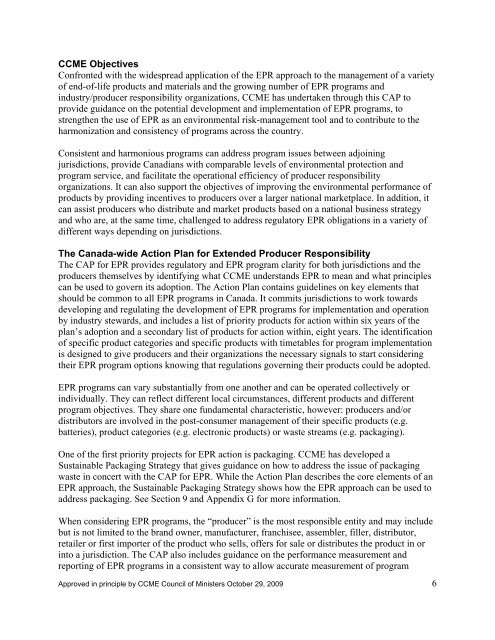Canada-Wide Action Plan for Extended Producer ... - CCME
Canada-Wide Action Plan for Extended Producer ... - CCME
Canada-Wide Action Plan for Extended Producer ... - CCME
You also want an ePaper? Increase the reach of your titles
YUMPU automatically turns print PDFs into web optimized ePapers that Google loves.
<strong>CCME</strong> Objectives<br />
Confronted with the widespread application of the EPR approach to the management of a variety<br />
of end-of-life products and materials and the growing number of EPR programs and<br />
industry/producer responsibility organizations, <strong>CCME</strong> has undertaken through this CAP to<br />
provide guidance on the potential development and implementation of EPR programs, to<br />
strengthen the use of EPR as an environmental risk-management tool and to contribute to the<br />
harmonization and consistency of programs across the country.<br />
Consistent and harmonious programs can address program issues between adjoining<br />
jurisdictions, provide Canadians with comparable levels of environmental protection and<br />
program service, and facilitate the operational efficiency of producer responsibility<br />
organizations. It can also support the objectives of improving the environmental per<strong>for</strong>mance of<br />
products by providing incentives to producers over a larger national marketplace. In addition, it<br />
can assist producers who distribute and market products based on a national business strategy<br />
and who are, at the same time, challenged to address regulatory EPR obligations in a variety of<br />
different ways depending on jurisdictions.<br />
The <strong>Canada</strong>-wide <strong>Action</strong> <strong>Plan</strong> <strong>for</strong> <strong>Extended</strong> <strong>Producer</strong> Responsibility<br />
The CAP <strong>for</strong> EPR provides regulatory and EPR program clarity <strong>for</strong> both jurisdictions and the<br />
producers themselves by identifying what <strong>CCME</strong> understands EPR to mean and what principles<br />
can be used to govern its adoption. The <strong>Action</strong> <strong>Plan</strong> contains guidelines on key elements that<br />
should be common to all EPR programs in <strong>Canada</strong>. It commits jurisdictions to work towards<br />
developing and regulating the development of EPR programs <strong>for</strong> implementation and operation<br />
by industry stewards, and includes a list of priority products <strong>for</strong> action within six years of the<br />
plan’s adoption and a secondary list of products <strong>for</strong> action within, eight years. The identification<br />
of specific product categories and specific products with timetables <strong>for</strong> program implementation<br />
is designed to give producers and their organizations the necessary signals to start considering<br />
their EPR program options knowing that regulations governing their products could be adopted.<br />
EPR programs can vary substantially from one another and can be operated collectively or<br />
individually. They can reflect different local circumstances, different products and different<br />
program objectives. They share one fundamental characteristic, however: producers and/or<br />
distributors are involved in the post-consumer management of their specific products (e.g.<br />
batteries), product categories (e.g. electronic products) or waste streams (e.g. packaging).<br />
One of the first priority projects <strong>for</strong> EPR action is packaging. <strong>CCME</strong> has developed a<br />
Sustainable Packaging Strategy that gives guidance on how to address the issue of packaging<br />
waste in concert with the CAP <strong>for</strong> EPR. While the <strong>Action</strong> <strong>Plan</strong> describes the core elements of an<br />
EPR approach, the Sustainable Packaging Strategy shows how the EPR approach can be used to<br />
address packaging. See Section 9 and Appendix G <strong>for</strong> more in<strong>for</strong>mation.<br />
When considering EPR programs, the “producer” is the most responsible entity and may include<br />
but is not limited to the brand owner, manufacturer, franchisee, assembler, filler, distributor,<br />
retailer or first importer of the product who sells, offers <strong>for</strong> sale or distributes the product in or<br />
into a jurisdiction. The CAP also includes guidance on the per<strong>for</strong>mance measurement and<br />
reporting of EPR programs in a consistent way to allow accurate measurement of program<br />
Approved in principle by <strong>CCME</strong> Council of Ministers October 29, 2009 6
















